Ceratomia hageni
Ceratomia hageni
seer-a-TOHM-ee-uhmm
HAY-gen-eye
Hagen's Sphinx or Osage Orange
Sphinx
Grote, 1874
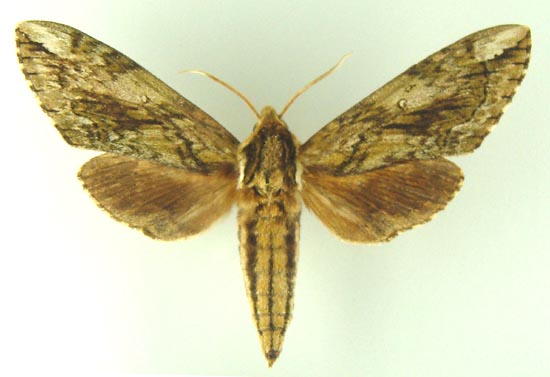
This site has been created by
Bill Oehlke at oehlkew@islandtelecom.com
Comments, suggestions and/or additional information are welcomed by Bill.
TAXONOMY:
Family: Sphingidae, Latreille, 1802
Subfamily: Sphinginae, Latreille, [1802]
Tribe: Sphingini, Latreille, 1802
Genus: Ceratomia Harris, 1839 ...........
Species: hageni Grote, 1874
|
MIDI MUSIC
.....It's a Wonderful World.....
copyright C. Odenkirk
ON.OFF
<bgsound src="world.mid" LOOP=FOREVER>
|
DISTRIBUTION:
Hagen's sphinx, Ceratomia hageni, (Wing span: 2 3/4 - 3 5/8 inches (7 - 9.2 cm)),
flies in Michigan south to Georgia and west to Nebraska, Kansas,
Oklahoma, and Texas. It is absent along the immediate east coast.
I was recently alerted by Curt Lehman of a sighting (September 2, 2013, with image) in Brooke County in northwestern West Virginia.
This represents an eastward expansion of its known range.
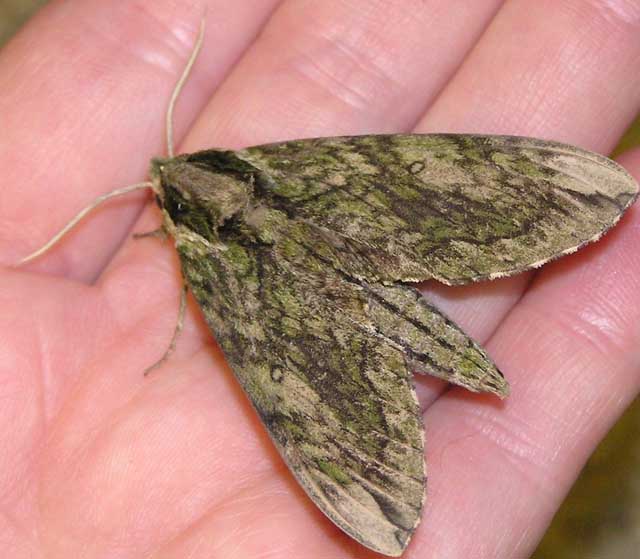
Ceratomia hageni, DeSoto, Dallas County, Texas, June 24, 2009, courtesy of Virginia Dyson.
The upperside of the forewing is gray with a green tint and has dark
indistinct wavy lines, and pale gray patches at the wing tip and
along the costa. The upperside of the hindwing is dark grayish brown
with paler gray at the base and outer margin.
I identified the moths below based primarily on the distinct pale
markings of the forewing apex, but more so by the pale submarginal area
with short, thin, black dashes emanating toward the body from the
midpoints of the dark areas of the fringe.
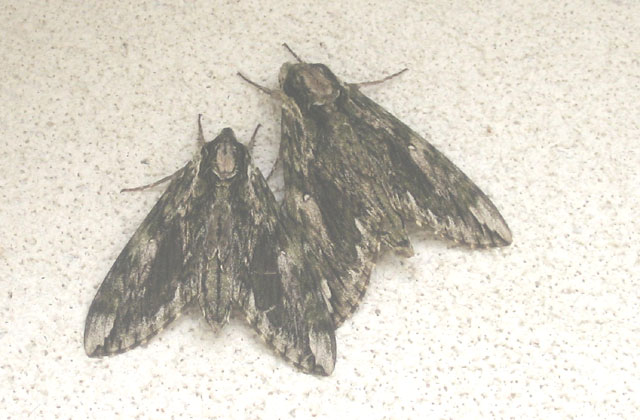
Ceratomia hageni, March 21, 2007, Ennis (Ellis Co.), Texas, courtesy of
Val Mansfield.
Warning: Val Mansfield writes, "I believe my one
year old labrador retriever consumed this insect and experienced a
violent reaction. She is currently in the animal hospital in stable
condition at 16 hours after consumption. However, her liver level is
elevated. Is the insect in the attached photo poisonous? Several of
these insects appeared in recent days. The insect body appears to be
3 1/2 inches with a wing span of 4 inches. I live in the country
near Ennis Texas."
I do not know if there is any correlation between the dog's illness and
the moth, but larvae of Ceratomia hageni feed on foliage of
Maclura pomifera (Osage Orange) and the fruit and foliage are
known to contain certain toxins.
One website reports, "Contact with the sap from this tree can cause
dermatitis (Schur 1932). Subsequent reports (Muenscher 1951, Gardner
& Bennetts 1956, Schwartz et al. 1957) are brief and may all derive
from Hurst (1942) and/or Schur (1932). It is by no means clear
whether the sap is irritant or sensitising or both."
The dog's illness may not even have been directly related to the moths,
but I would not be surprised if the milky sap of this plant can cause
allergenic reactions in and of itself, and I also would not be
surprised if it binds itself to certain toxic substances either
naturally occuring in the soil or introduced through environmental
spills or discharges.
FLIGHT TIMES:
Osage Orange
Sphinx adults fly in two flights from March-April-September with possibly
three-four flights in Missouri from May-October.
Vernon A. Brou confirms there are at least four generations annually
in Louisiana.
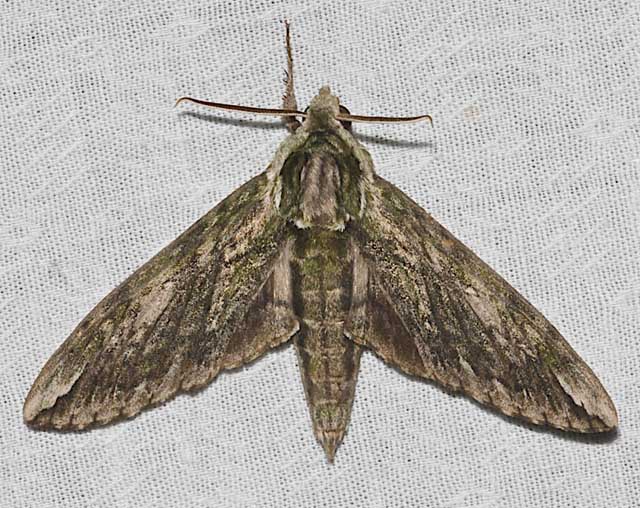
Ceratomia hageni, Woodbury, Cannon County, central Tennessee,
May 12, 2010, courtesy of Carol Wolf.
ECLOSION:
Pupae probably wiggle to surface from
subterranean chambers just prior to eclosion.
SCENTING AND MATING:
Females call in the males with a pheromone released from a gland at the tip of the
abdomen. Adults, which fly at dusk, nectar at a variety of flowers.
EGGS, LARVAE, PUPAE:
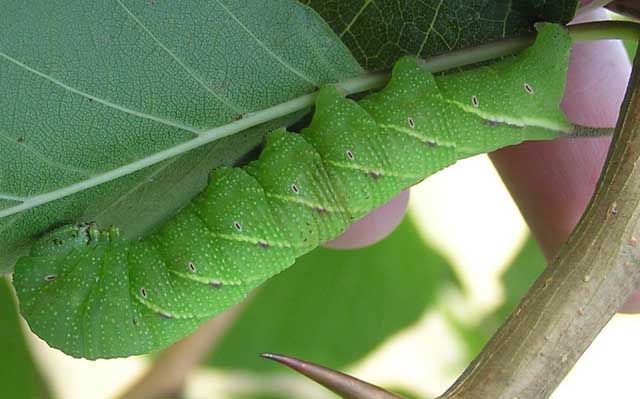
Ceratomia hageni fifth instar on Bois D’arc (Maclura pomifera) tree, DeSoto, Dallas County, Texas,
July 8, 2009, courtesy of Virginia Dyson.
Larvae feed on osage orange (Maclura pomifera).
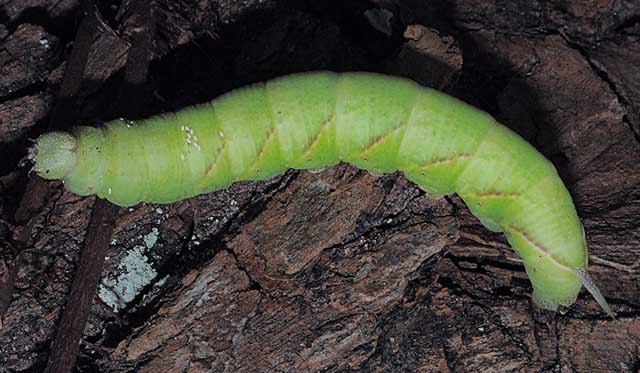
Ceratomia hageni, Jasper, Newton County, northwestern Arkansas,
October 5, 2009, courtesy of Bob Barber.
Bob Barber writes, "This was on a large stump below two large Osage-orange, Horse-apple or Bois D'Arc (Maclura pomifera) trees.
Looking for a place to pupate. Location is Jasper, Newton County, Arkansas, on 10/05/09.
I was told you might be interested. I didn't notice it was parasitized until I got back to my cabin and downloaded the
pictures, and I left it where I found it."
Return to U. S.A. Table
Return to Sphingidae Index
Return to Sphingini Tribe
Enjoy some of nature's wonderments, giant silk moth cocoons.
These cocoons are for sale winter and fall. Beautiful Saturniidae moths will emerge the following spring and summer.
Read Actias luna rearing article.
Additional online help available.
Eggs of many North American species are offered during the spring and summer. Occasionally
summer Actias luna and summer Antheraea polyphemus cocoons are available. Shipping to US destinations is done
from with in the US.
Use your browser "Back" button to return to the previous page.
This page is brought to you by
Bill Oehlke and the
WLSS. Pages are on space rented from Bizland. If you would like
to become a "Patron of the Sphingidae Site", contact Bill.
Please send sightings/images to Bill. I will do my best to respond to
requests for identification help.
 | 
Show appreciation for this site by clicking on flashing butterfly to the left.
The link will take you to a page with links to many insect sites. |







